April 15, 2022
Air Date: April 15, 2022
FULL SHOW
SEGMENTS
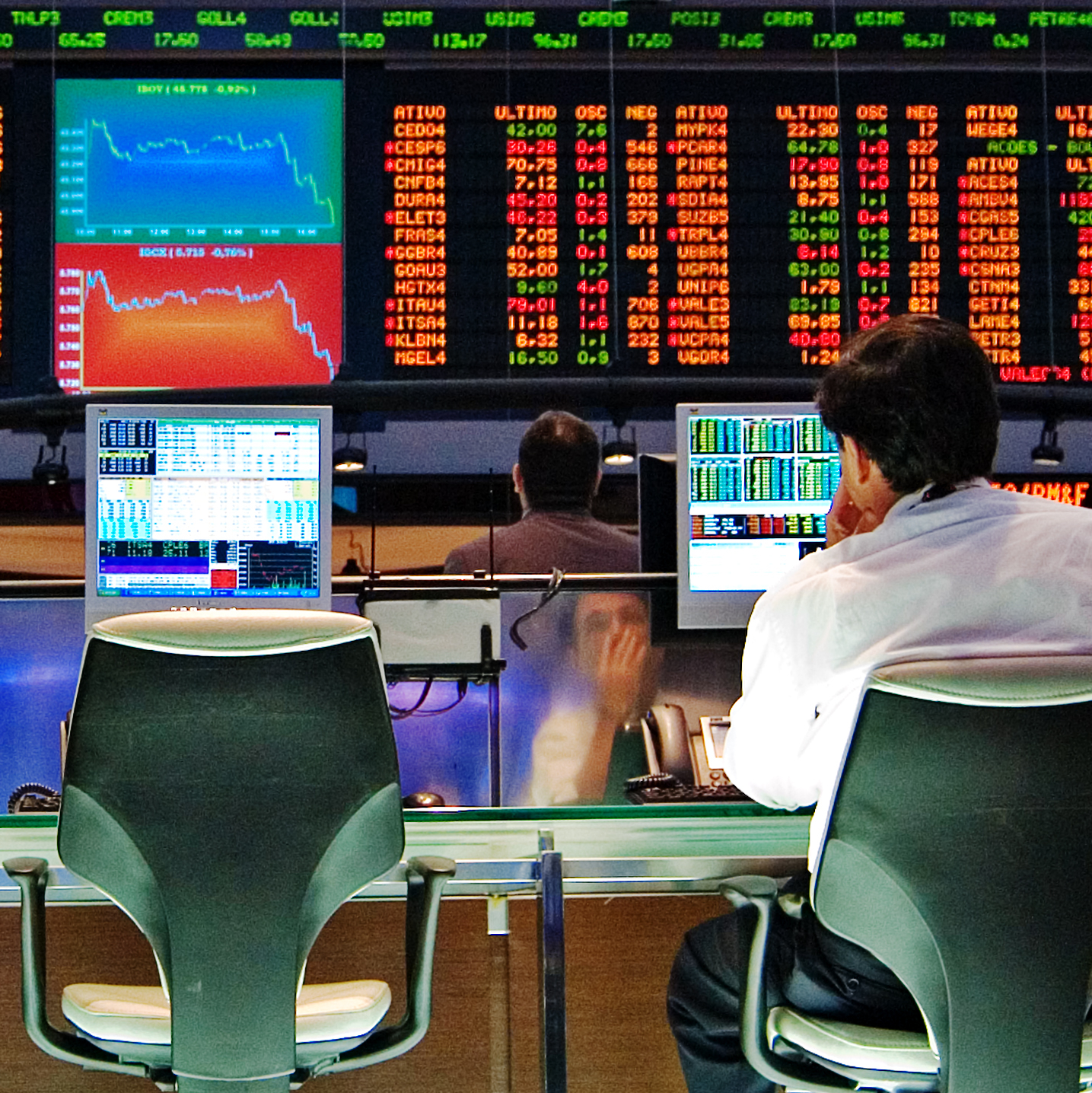
Climate Risk Disclosure Mandate
View the page for this story
Trillions of dollars of financial assets are at risk of losses related to the climate, so the Biden Administration is now moving to require public companies to disclose their climate risk. Host Steve Curwood talks to Jody Freeman, Harvard Law professor and former Obama White House official, about the proposed Securities and Exchange Commission mandate. (08:24)
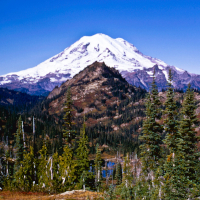
Beyond the Headlines
/ Peter DykstraView the page for this story
Environmental Health News editor Peter Dykstra joins Host Bobby Bascomb to discuss how scientists at Stanford University have configured solar panels to produce a bit of electricity at night. On a somber note, a report finds that more than half of the 358 human rights activists who were murdered last year were in the business of defending land and native rights. Lastly, they commemorate the 50th anniversary of the Supreme Court case Sierra Club v. Morton, when the dissent of Justice William O. Douglas argued that inanimate objects like forests can have legal standing. (04:36)
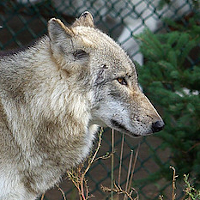
Massive Government Animal Culling
View the page for this story
Wildlife Services, a division of the U.S. Department of Agriculture, killed an estimated 1.75 million animals in 2021, including bears, wolves and beavers among 400,000 native animals. USDA claims these exterminations protect agriculture and public health, but opponents say there are better ways to deal with animals that present problems for humans. Collette Adkins, the Carnivore Conservation Director and Senior Attorney at the Center for Biological Diversity tells Host Bobby Bascomb about the harms of these killings and offers more humane options for preventing animal-human conflicts. (09:13)

New Telescope to Unlock Mysteries of the Universe
View the page for this story
The new James Webb Space Telescope is by far the most powerful space telescope ever built. When the telescope is fully operational, it will be able to see up to a hundred galaxies at once and detect the light emitted from some of the universe's very first stars. It can also look for conditions compatible with life on planets near and far. Dr. Stefanie Milam is the Deputy Project Scientist for Planetary Science for the James Webb Space Telescope, and she joins Host Steve Curwood to explain how the telescope will help advance science. (20:56)
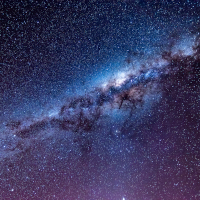
“How to Love the Stars”
/ Jennifer JunghansView the page for this story
You don't need a $10 billion telescope to take in the wonder of the universe. You can make a simple one yourself, or even just look up with your own two eyes. And for writer Jennifer Junghans, that connection to the stars also represents a connection to her dad. (03:46)
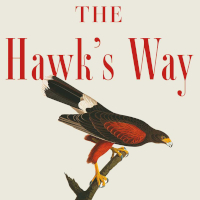
The Living on Earth Book Club is Back!
View the page for this story
Join Living on Earth for our first in-person author interview since 2020! Host Steve Curwood will talk with bestselling author Sy Montgomery about her new book The Hawk’s Way: Encounters with Fierce Beauty, a celebration of one of nature’s most perfect and mysterious creatures. ()
Show Credits and Funders
Show Transcript
HOSTS: Bobby Bascomb, Steve Curwood
GUESTS: Collette Adkins, Jody Freeman, Stefanie Milam
REPORTERS: Peter Dykstra, Jennifer Junghans
[THEME]
CURWOOD: From PRX – this is Living On Earth.
[THEME]
CURWOOD: I’m Steve Curwood.
BASCOMB: And I’m Bobby Bascomb
The Biden Administration wants to require companies to disclose financial risks they face from climate disruption.
FREEMAN: It's the very first time officially a financial regulator in the United States has said climate change is relevant to business risk. It also goes to show the federal government is taking a very expansive approach to climate now.
CURWOOD: Also, NASA recently launched a space telescope capable of looking into deep space and possible signs of life.
MILAM: So with the James Webb Space Telescope, we’re actually looking at fingerprints of really interesting molecules like water, carbon dioxide, methane. These are all molecules that should be ringing a bell of things that are signs of life, or even habitability.
CURWOOD: That and more this week on Living on Earth – Stick Around!
[NEWSBREAK MUSIC: Boards Of Canada “Zoetrope” from “In A Beautiful Place Out In The Country” (Warp Records 2000)]
[THEME]
Climate Risk Disclosure Mandate
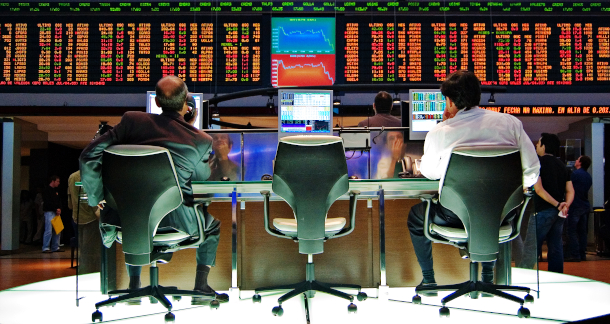
The SEC’s proposed plan would require public companies to disclose how they are going to deal with climate-related financial risks. (Photo: Rafael Matsunaga, Wikimedia Commons, CC BY 2.0)
BASCOMB: From PRX and the Jennifer and Ted Stanley studios at the University of Massachusetts, Boston this is Living on Earth. I’m Bobby Bascomb
CURWOOD: And I’m Steve Curwood.
Trillions of dollars of financial assets are at risk of losses related to the climate, experts say, so the Biden Administration is now moving to require public companies to disclose their climate risk. The US Securities and Exchange Commission, known as the SEC, makes rules designed to protect investors and markets. And on March 21st the SEC started down the road to make a rule that will compel publicly traded companies to disclose both direct and indirect risks to their businesses from climate disruption, a rule that would likely go into effect in another year or two. It’s part of the growing trend of disclosure of ESG, that is the Environmental, Social, and Governance aspects of businesses, beyond simple profits and losses. Jody Freeman, a Harvard law professor and former Counselor for Energy and Climate Change in the Obama White House, joins us now to explain. Welcome to Living on Earth!
FREEMAN: Great to be with you, Steve.
CURWOOD: You know, studies show that companies that have more maturity with ESG seem to have more economic value for investors—they have a better performance. Why is that do you think?
FREEMAN: I sit on the board of an oil and gas company myself, and ESG has come roaring along in the last couple of years. There's been a lot of investor pressure on companies to talk more about how they approach environmental challenges and social challenges and how they address all kinds of governance issues. I think it makes companies better. Good governance means probably better performance.
CURWOOD: Now, how long has the Securities and Exchange Commission been asking about climate? And what has it asked?
FREEMAN: This is the first time that the SEC is requiring disclosure. I mean, this proposal would require public companies to disclose how they approach climate related financial risks, how they assess that risk, whether they think their physical infrastructure might be at risk, how they're thinking about the transition to cleaner energy. So it's a very significant thing for this to be mandatory now. And we will see how this unfolds because they've put it out for public comment.
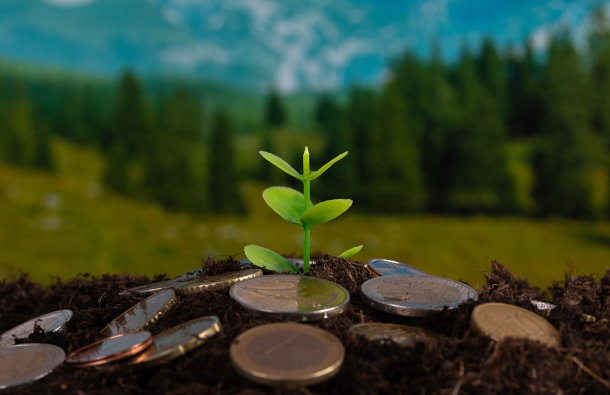
Climate change disrupts all aspects of business activity, notably supply chains, labor supply, and physical capital. Amid the uncertainty, investors are demanding more information from corporations about the risks that climate-change poses to their assets and investments. (Photo: Jernej Furman, Flickr, CC BY 2.0)
CURWOOD: Looking it over, I was surprised to see they're talking about three different things to be concerned about when it comes to the climate: a climate transition plan, and then looking at not only what a company has in terms of its own emissions, but what companies that they're working with, how their greenhouse gas emissions might be involved in all of this. So it's not only direct emissions, but indirect emissions.
FREEMAN: Yes, this is a very comprehensive proposal that wants disclosure around the risks that a company itself faces, but also its own greenhouse gas emissions, as you just mentioned. Now, it's not requiring necessarily disclosure of downstream emissions from say, the products they produce. Those are called scope three, and people aren't quite sure yet about how to account for those. But the proposal does say that if it's material to disclose those scope three emissions, that they should do so so it will provide some visibility to investors, about how the companies approach these climate risks, how they think about it, and how they decide whether the risks are material or not. What the SEC is doing is to say climate change touches every aspect of a business now, and you have to think about that going forward, because it poses risks to investors.
CURWOOD: Because we're talking about the investment world, typically, the Securities and Exchange Commission looks at the materiality of what's going on in terms of value to the shareholders. But if you have to think about environmental, social and governance issues, that's much broader than just the bottom line for shareholders—it's how a company might operate in the community. These go beyond these traditional categories of being in the best interest of shareholders.
FREEMAN: Well, I don't know about that. The SEC has been very careful here to link these disclosures to financial risks because of climate change. They're not trying to force companies to do something about climate change. You know, 60% of Fortune 500 companies have already got climate resolutions, and something like 17% of those have net zero goals, and 72% of investors don't believe them, they don't think they're gonna meet those goals. What that tells you is investors are clamoring for information. That's what this rule, I think, is seeking to do.
CURWOOD: So someone listening to us might say, Hey, I don't have a lot of personal wealth, I don't own common stock. Well, I'm not in that world. How relevant is this proposed rule to everyone in this society?
FREEMAN: Well, a lot of us have retirement accounts with asset managers. And they need to know. Even if you think of yourself as a small fish, you're probably going to care about the decisions that your asset managers are making. And it will help provide some visibility into how they approach these issues.
CURWOOD: Now, I understand that there may well be some pushback from elements of industry and commerce for this rule. What kind of pushback do you expect to see and what do you think their concerns are gonna be?
FREEMAN: Well, we've already seen some members of Congress who have reacted to say, you know, the Securities Exchange Commission is a financial regulator. It has no business being a climate regulator, that kind of thing. And I think what that foreshadows, Steve, is some legal challenge to come where we would expect petitioners to go into court and say, the SEC doesn't have the legal authority to do this, you should leave that to the Environmental Protection Agency. We're hearing all the usual complaints that come from regulatory proposals, you know, that they're not necessary, they're too expensive, the agency's overreaching. But I think this has been done very thoughtfully by the SEC. And it's trying to stick to its core mission here, which is under the law that it administers, protecting investors and protecting the integrity of markets.
CURWOOD: I can't resist asking you because you are a lawyer, given the conservative bent of the courts, one might think that they would perhaps be receptive to complaints that the SEC should not be dealing with climate, Congress should be passing the law rather than having regulators do it.
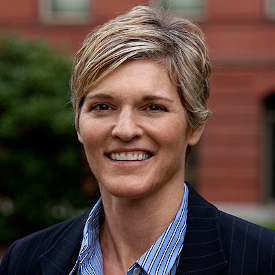
Jody Freeman is the Archibald Cox Professor of Law at Harvard Law School and the former Counselor for Energy and Climate Change at the Obama Whitehouse. (Photo: Courtesy of Jody Freeman)
FREEMAN: Yes, you're really on to something there. I think there is a feeling that the 6-3 conservative majority of the court is very skeptical about expansive agency regulation, and that the interest groups and businesses that want to challenge these rules are going to find a sympathetic audience in the court. We've already seen a couple of Supreme Court decisions recently, in which they've struck down agency rules for being in their view, an overstep beyond what Congress has authorized. But meanwhile, if the SEC can finish this rulemaking and get it out, the behavior of public companies will start to change. It will become more and more routine to disclose to investors your climate related risk, it will become embedded and expected from businesses. And I think that's really important, because right now, you have a lot of non-governmental organizations asking for this information in different formats. And so what this does is say, we are now the cop on the beat. We want to provide this information in a standard way to investors. I think that's an improvement. And I think it will further embed climate related risk planning into business practices as something that's standard and expected.
CURWOOD: Professor Freeman, you're very close to this sort of thing and your work, both at Harvard Law School and in the Obama White House. How important is this rulemaking do you think given our situation with the climate?
FREEMAN: You know, I think this rule is extremely important, because it's the very first time officially, a financial regulator in the United States has said climate change is relevant to business risk. It also goes to show that the federal government is taking a very expansive approach to climate now, not just thinking about how do we reduce greenhouse gas pollution, but thinking about the economic risk that comes with climate change. And I think it's very important for people to understand that we're moving into an era where we think of climate touching everything: touching financial risks, touching national security risk. And I think that's very helpful for progress on climate policy.
CURWOOD: Jody Freeman is a professor at Harvard Law School and a former Obama administration official. Thanks so much, Jody, for taking the time with us today.
FREEMAN: Thanks. Great to be with you.
Related links:
- New York Times March 21, 2022: The S.E.C. moves closer to enacting a sweeping climate disclosure rule.
- SEC’s new ESG Disclosure Proposal
- Jody Freeman’s Website
- SEC’s Press Release about the new Disclosure Proposal
Beyond the Headlines

View of Mt Rainier from Cougar Lakes area of William O. Douglas Wilderness, named after the Supreme Court Justice, on the Gifford Pinchot National Forest in Washington's Cascades. (Photo: U.S. Forest Service – Pacific Northwest Region, public domain)
BASCOMB: Well, it's time for a trip now beyond the headlines with Peter Dykstra. Peter is an editor with environmental health news. That's ehn.org and dailyclimate.org. Hey there, Peter, what do you have for us this week?
DYKSTRA: Well, hi, Bobby. One of the things that I just love about following Science and Environment issues, some things come at you totally out of the blue. Here's one that appeared last week in the journal Applied Physics Letters. And that's engineers and scientists at Stanford University, have found a way to have a solar panel generate electricity at night.
BASCOMB: Hmm, what now? You know, it's a little late for April Fool's here, Peter.
DYKSTRA: Yeah. And peer reviewed journals generally don't do April Fool's jokes. But here's what happened through the process of radiative cooling solar cells, like a whole lot of engineered things cool down slower than the night air. And the scientists have found a way to use that heat photons leaving the solar panels as they cool to provide a little extra bonus energy.

A boat ramp is being illuminated by solar powered lighting at night running from batteries. Brighter nights may follow as scientists at Stanford have found a way to generate electricity at night using solar panels. (Photo: Klau1983, Wikimedia Commons, CC BY-SA 3.0)
BASCOMB: Hmm, well, how little are we talking about here?
DYKSTRA: That's probably a very little little, possibly this is more curiosity than a breakthrough. But it's interesting just the same.
BASCOMB: Well, what else do you have for us this week?
DYKSTRA: A report out from two non government groups, Frontline Defenders, and The Human Rights Defenders Memorial, recorded that there were as many as 358 murders of human rights activists around the world in 2021. And that more than half of those activists killed were in the business of defending land and defending Native rights.
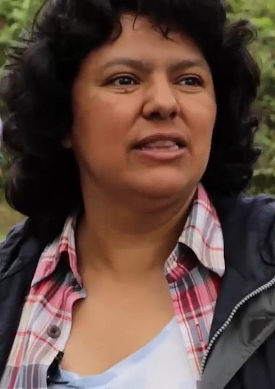
This is a photo of Honduran activist Berta Caceres, recipient of the 2015 Goldman Prize, most notable for being an environmentalist and fighting for the rights of indigenous people. She was murdered a year after receiving the prize. (Photo: UN Environment, Wikimedia Commons, CC BY 3.0)
BASCOMB: Yeah, it's an awfully dangerous thing to do to be a defender of the environment in so many places in the world. Here on the show, we've talked in the past about Berta Caceres. She won the Goldman prize in 2015, for her activism in opposition to a dam in Honduras, but she was killed just a year later, in 2016.
DYKSTRA: Murdered a year later, she gave her life fighting against this dam project. But the dam project eventually went away. Seven people were arrested after the international pressure and outrage about her death took hold. The dam project lost its funding. But this kind of thing happens round the world. The deaths took place in Latin America, in Africa and in Asia. The worst offenders were Colombia, Mexico and Brazil. Honduras is up there in the per capita basis as well. Here in this country, activists get beaten up, they lose their jobs, things like that. But rarely, if ever, does anybody get killed. So in the developing world, it's a different story.
BASCOMB: Mm hmm. Yeah. And you've always been great about reminding us of that. So so thank you. I hope though, that maybe you have something a little bit happier for us from the history books this week. What do you see?
DYKSTRA: A little bit happy but just fascinating, a 50th anniversary because on April 19 1972, the US Supreme Court heard a case Sierra Club vs. Morton. The Sierra Club actually lost this case in their opposition to a planned ski resort project of The Walt Disney Company right near Sequoia National Park. The dissenting opinion came from a remarkable man named Justice William O. Douglas, an absolute tree hugger on the Supreme Court, who'd have thunk it, who said that the forest itself had a stake in the case, quote, inanimate objects are sometimes parties in litigation.
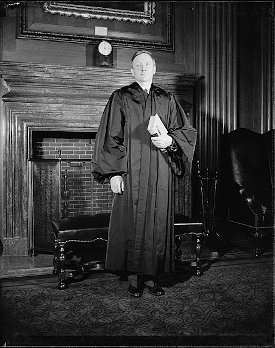
In a dissenting opinion in the case of Sierra Club v. Morton, Justice William O. Douglas argued that inanimate objects, like trees or other natural entities, should have legal standing to sue in court. (Photo: Harris & Ewing, Public Domain)
The Sierra Club lost but a subsequent lawsuit stopped the building of the resort. William O. Douglas was a fascinating guy, a sitting Supreme Court Justice, who led a protest hike against another dam project along the Delaware River. He for years gave the court a green perspective as it were. He's someone that's not remembered often enough these days.
BASCOMB: That's amazing. So a sitting Supreme Court Justice argued that the standing forest had standing, legal standing in this case.
DYKSTRA: Just like the Lorax he spoke for the trees.
BASCOMB: All right. Well, thanks, Peter. Peter Dykstra is an editor with environmental health news. That's ehn.org and dailyclimate.org. We'll talk to you again real soon.
DYKSTRA: All right, Bobby, thanks a lot. Talk to you soon.
BASCOMB: And there's more on these stories on the Living on Earth website. That's loe.org.
Related links:
- NPR | “Solar Panels That Can Generate Electricity at Night Have Been Developed at Stanford”
- Mongabay | “More Than Half of Activists Killed in 2021 Were Land, Environment Defenders”
- Sierra Club v. Morton
[MUSIC: Tom Bailey “LIA” Single, Little Saigon Records]
CURWOOD: Coming up the USDA’s Wildlife Services agency killed more than a million animals last year deemed as nuisances to humans. Keep listening to Living on Earth.
ANNOUNCER: Support for Living on Earth comes from Sailors for the Sea and Oceana. Helping boaters race clean, sail green, and protect the seas they love. More information @sailorsforthesea.org. Support also comes from Friends of Smeagull the Seagull and Smeagull’s Guide to Wildlife. It’s all about the wildlife right next door to you! That’s Smeagull, S - M - E - A - G - U - L - L, SmeagullGuide.org.
[CUTAWAY MUSIC: Julian Lage “Nocturne” on Arclight, Mack Avenue Records II, LLC]
Massive Government Animal Culling
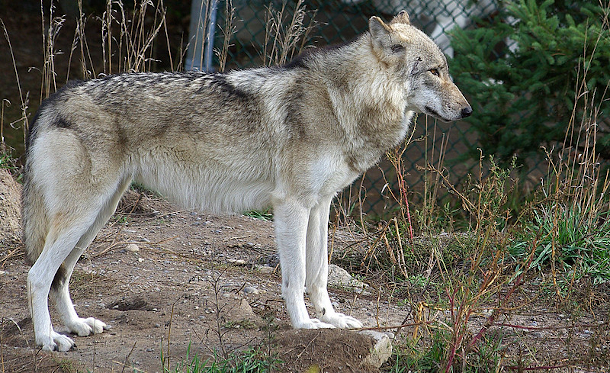
While the majority of animals killed by Wildlife Services are invasive species, some native species like the gray wolf are also in the line of fire. (Photo: Property #1, Flickr, CC BY-NC-ND 2.0)
CURWOOD: It’s Living on Earth, I’m Steve Curwood.
BASCOMB: And I’m Bobby Bascomb
Wildlife Services, a division of the US Department of Agriculture, killed 1.75 million animals in 2021. The majority of the animals culled are invasive species that can cause environmental damage but over four hundred thousand of the animals killed were native species including bears, beavers, and vultures. The agency claims these exterminations protect agriculture and public health. But opponents say there are better ways to deal with animals that present problems for humans. For more, I’m joined now by Colette Adkins, the Carnivore Conservation Director and Senior Attorney at the Center for Biological Diversity. Colette, welcome to Living on Earth.
ADKINS: Thank you for having me.
BASCOMB: So as I understand it, the vast majority of these animals are invasive species, including European Starlings--that's the majority--and feral pigs. Invasive animals, as we know, can be damaging to native ecosystems. So, you know, culling them, I think we could understand maybe the reasoning behind that. But plenty of the animals killed are actually native, like gray wolves and beavers. Why is that? What's going on here?
ADKINS: Yeah, it's so frustrating that, you know, even really ecologically important, and even rare animals are targeted by Wildlife Services. You know, hundreds of wolves, I think it was about 24,000 Beavers. So you know, it depends species to species in terms of like, why they're doing this. But for example, coyotes, about 60-70,000 are killed each year, shot and trapped, poisoned. Wildlife Services says they need to do this to protect the livestock industry.
BASCOMB: And beavers, I would assume are flooding agricultural land, that sort of thing?
ADKINS: Yeah, that's right. You know, beavers build dams in places people don't like that could flood a roadway, or maybe they chew on some tree in a park. But there's methods like for example, if there's trees that need to be protected, you can wrap them very cheaply with like a chicken wire. Or with these dams, there's these devices called "Beaver Deceivers" that can allow them to do their instinctive dam building, but still allow enough flow through the dam to prevent any flooding of roadways. For almost every excuse Wildlife Services gives, the conservation community can come up with a slew of alternative methods that they could use that wouldn't involve just killing the animals.
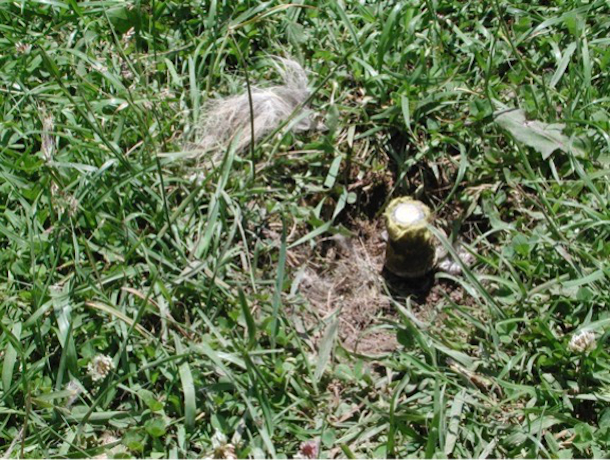
M-44 cyanide “bombs” are among the most controversial devices that Wildlife Services employs to exterminate animals. (Photo: USDA APHIS Wildlife Services)
BASCOMB: And what kind of alternatives can you offer for you know, people that have a lot of livestock that might be vulnerable to wolves or coyotes?
ADKINS: First of all, let me emphasize that only a very small percentage of farms do have problems with wildlife because most of them just do these good common sense practices. Usually, when farms have problems with predators, it's because there's attractants there. So for example, if you've got a dead animal, just not leaving it out in the pasture, you know, the smell of a carcass will attract a predator. Or if you have vulnerable animals, like cows that are calving, to bring those into the barn, instead of leaving them out in the field, or making sure that wounded or sick animals get prompt veterinary care. There's a lot of scare devices that can be used, like motion sensing lights, or sound devices that would scare away predators. And then things like guard dogs or fencing, or just having humans around. I mean, we all know just from our experience with wildlife in the woods, they don't like people, they're scared of us. So if you have activities that either simulate human presence, like flashing lights or noise, or have people around, you're not gonna to have a problem with predators.
BASCOMB: And then if you do all of those things, and still have, you know, a problem with predators, is there a case to be made for the federal government maybe reimbursing ranchers instead of, you know, going through the expense of killing predators and all of the, you know, ecological problems that might be associated with that?
ADKINS: Yeah, I think that, you know, we are supportive of compensation programs, especially when it's federally protected animals that are doing the harm, like wolves or grizzly bears. But some of this really should be considered a business expense. You know, every business has some losses. And I don't think the federal government needs to be tasked with making the livestock industry even more profitable than it already is.
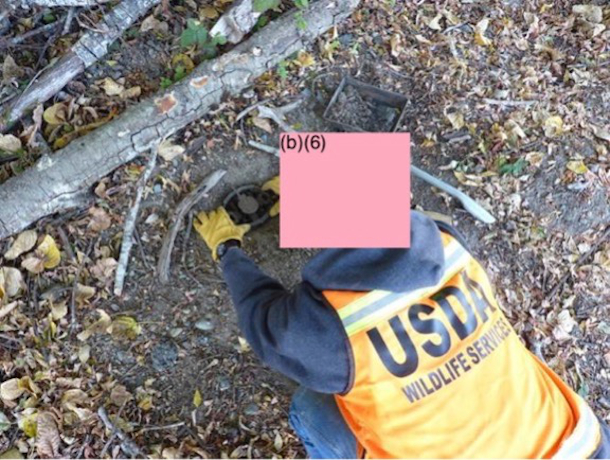
Many activists are concerned with Wildlife Services’ use of leg traps, which indiscriminately capture any animal that treads across them. (Photo: USDA APHIS Wildlife Services)
BASCOMB: Did you just say that some animals that are federally protected are still on this kill list from Wildlife Services? How is that possible?
ADKINS: Well, the Endangered Species Act has two levels of protection: "threatened" and "endangered." And for grizzly bears, for example, they're listed as "threatened." And that allows federal agents to kill grizzly bears to protect livestock. And in Minnesota where I live, wolves have "threatened" status. So Wildlife Services will come out to farms and ranches and, and shoot and trap wolves.
BASCOMB: And when these native species are killed, what are the potential effects within the ecosystem? I mean, we've been talking a bit about predators here, you know, like apex predators are pretty important to their ecology.
ADKINS: Oh, for sure. These are terribly important animals that we're talking about here. Take these apex predators, for example, in Yellowstone, got elk moving, and that reduced the amount of over-browsing the elk were doing along river ways. And that led to increased diversity of songbirds, it allowed the willows near the rivers to grow up and stabilize the banks, it actually ended up changing the way the rivers flowed. You know, beavers have the same sort of, they call them trophic cascades, these you know, ripple effects. So beavers for example, they create these flooded wetland areas and slow moving water that are just ideal settings for you know, really important animals like endangered salmon, but also things like waterfowl and and other native freshwater fishes. These are animals that are doing us services, ecological services, and we shouldn't be so trigger happy honestly, when it comes down to it. We should find ways to coexist with these animals.
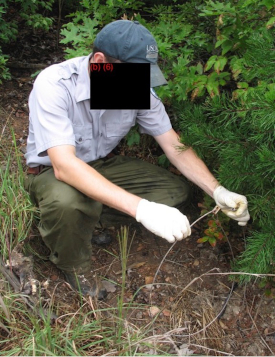
Neck snares have been successfully banned in some areas due to legal action taken by the Center for Biological Diversity. (Photo: USDA APHIS Wildlife Services)
BASCOMB: Now, I suspect I don't really want to hear the answer to this question, but I must ask it anyway. How are these animals being killed frequently?
ADKINS: Well, that's the thing that for me personally, is just so objectionable about it is that these methods, they're not only indiscriminate, in many cases, killing the animals that aren't even targeted. But they also cause immense suffering. But in terms of like the indiscriminate nature, just last year, Wildlife Services killed more than 2700 animals that they didn't even try to kill. That's because the methods that they use--things like strangulation snares, and leghold traps, and poisons will kill whatever comes across the device. So consider, for example, these neck snares. These are intended to strangle animals to death. Foothold traps, I mean, we've all heard of those awful stories of animals chewing their legs off to free themselves. It just is-- it's horrible to think about. And then poisons. Poisons that pose a threat not only to animals, but even people. For example, M 44 cyanide bombs. These are some of the most controversial devices that Wildlife Services uses. This year marks the five year anniversary of an Idaho teen who came across one of these in a field behind his house. He thought it was a sprinkler head. He bent down and kind of plucked at it and it shot out toxic cyanide powder. He was temporarily blinded, his dog died. It's really a tragic situation.
BASCOMB: What kind of pushback, if any, are you seeing from state or local municipalities in response to these practices by Wildlife Services?
ADKINS: That's one thing that's left us feeling pretty hopeful that we are gonna to see additional change. So for example, Oregon passed a state law that banned use of those M 44 cyanide bombs. There's other states too, that now don't use them anymore. California and Arizona are examples. Sometimes individual counties or even cities, led by a few outraged citizens that find out about Wildlife Services, will get local ordinances or even just canceling the contracts. So here in Minneapolis where I live, people found out how many beaver Wildlife Services were killing, got the city to revise its contract with Wildlife Services to only allow non lethal methods like wrapping those trees in the parks that Wildlife Services was killing the beavers for chewing. And in response to litigation too, that's one of the roles that we play at the Center for Biological Diversity is trying to hold Wildlife Service's accountable to these federal laws like the Endangered Species Act and the National Environmental Policy Act. We've had success in lots of different states, reining in some of the most really barbaric and environmentally harmful methods that Wildlife Services use. So for example, a couple years ago in in Washington State, in response to one of our lawsuits, Wildlife Services agreed to stop using those strangulation snares, so I do think that with additional pressure we'll see changes.
BASCOMB: Collette Adkins is the Carnivore Conservation Director and Senior Attorney at Center for Biological Diversity. Collette, thank you so much for your time today.
ADKINS: Oh, it was a pleasure to speak with you Bobby. Thank you.
Related links:
- US Department of Agriculture | “Program Data Reports”
- US Department of Agriculture | “Operational Activities”
- The Revelator | “The Big Picture: Cyanide Killers”
- Center for Biological Diversity | “Public Outcry Prompts Minneapolis Park Board to Prioritize Nonlethal Responses to Wildlife Conflicts”
- Center for Biological Diversity | “Legal Action Halts Federal Use of Strangulation Snares in Washington”
[MUSIC: Tord Gustavsen Trio “The Circle” on Opening, ECM Records GmbH]
New Telescope to Unlock Mysteries of the Universe

An artist’s rendering of the James Webb Space Telescope, with the multilayered sunshield stretched out beneath the observatory’s honeycomb mirror. (Photo: Adriana Manrique Gutierrez, NASA, Public Domain)
CURWOOD: We all experience gravity anytime we drop an object. But science has yet to explain just how gravity works. Is it a force? Is it a curvature in space time, as Albert Einstein suggested? And along with the mystery of gravity there is also so-called dark matter, which seems to occupy more than 80 per cent of the universe, but we still can’t see it or explain it. Well, two recent amazing developments may help bring some answers. A subatomic particle called the W Boson was discovered back in 1983 but earlier this month scientists reported new measurements of its mass that upend the conventional rules of physics, rules by the way, that have failed to explain gravity and dark matter. Meanwhile on last Christmas Day the massive James Webb Space Telescope was launched into an orbit a million miles above Earth and will start sending back pictures by this summer.
The Webb Telescope can look far deeper into space and further back in time than its predecessor, the Hubble Telescope. Not only will the Webb Telescope see stars born much closer to the so-called Big Bang beginning of our universe, its higher resolution images of super novas and galaxy motion might provide more insight into the phenomena of dark matter and gravity. And because it looks at infrared light it will also help in the search for signs related to life on other planets, both near and far. Here to tell us more about the extraordinary Webb telescope, is Stefanie Milam, the Deputy Project Scientist for Planetary Science at NASA. Stefanie, welcome to Living on Earth!
MILAM: Thank you so much for having me.
CURWOOD: So Stefanie, before we begin talking in detail about this, explain to somebody who really maybe hasn't heard much about this, what kind of telescope we're talking about here.
MILAM: So the space based telescope, the James Webb Space Telescope, is called the successor to the Hubble Space Telescope. So this is NASA's next big astrophysics space telescope that we launched on Christmas Day. And it is going to be looking for the first stars and galaxies across the universe.
CURWOOD: So it's gonna take a look at deep space and way back in time, but also I understand it can look in the local neighborhood at some things.
MILAM: Absolutely. So that was my role on this project actually, was to make sure that not only this extremely sensitive telescope that's studying you know, the farthest reaches of the universe can study first stars and galaxies and planets around other stars, but we can look at things much closer to home. We wanted this to be an all-purpose general observatory that the entire astronomy community could use the way that we've used the Hubble telescope to look at things like Mars or Jupiter or Saturn. But we also study things like distant stars and galaxies and planets around other stars. So we wanted James Webb Space Telescope to offer the same sort of capabilities. And it's extremely hard to look at things in our own neighborhood because they're so bright. And also they move with respect to the other stars, our whole solar system is moving constantly. So being able to track something moving across the sky with respect to background stars, and galaxies, is a whole different capability that a lot of telescopes, especially smaller ones aren't necessarily designed to do.
CURWOOD: The Hubble Telescope still makes remarkable scientific discoveries regularly. I think, just recently, it spotted the most distant star ever detected so far in the universe. So what sets the James Webb Space Telescope apart from the Hubble?
MILAM: So that was an amazing discovery that just happened and a very exciting one. Seeing the farthest star that we've ever been able to observe with the Hubble Space Telescope only motivates and excites the astrophysics community to what the opportunities the James Webb Space Telescope is going to enable. So we have an extremely sensitive telescope, we're 100 times more sensitive than the Hubble Space Telescope at infrared wavelengths. So what the James Webb Space Telescope is actually optimized for is infrared light. So it's like night vision goggles, we're seeing these tiny little faint heat signals across the universe, from when the first stars and galaxies were actually born, right after the Big Bang. So the James Webb Space Telescope is going to look even further back in time than what the Hubble Space Telescope because it's looking at these longer wavelengths of light, because the universe is expanding, and that light is moving away from us, it stretches the light that we would see, for example, with our own sun, or stars in our own galaxy, to longer and longer wavelengths. And so by looking in the infrared with an even more sensitive telescope than the Hubble, we'll be looking at stars that are even older or even further back in time. So, really exploring that sort of infant years of the universe is something that's very exciting, especially for the astrophysics and cosmology communities.
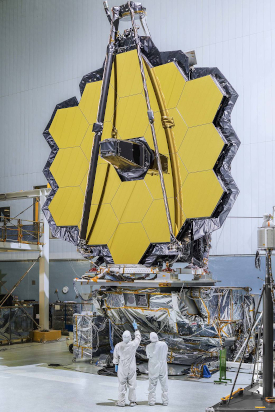
Scientists observe the main mirror assembly of the James Webb Space Telescope in November 2016. (Photo: NASA, Public Domain)
CURWOOD: Stefanie, please give us a brief overview of what your role is on the Webb telescope project. I mean, what were you working on before the launch on Christmas Day? And what are you doing now that the telescope has reached its orbit?
MILAM: So, I've been working on this project for about a decade, they brought me on to make sure that this space telescope can study things in our own solar system. So, things like Mars, asteroids, comets, Pluto, or even things like the rings of Saturn, or tiny little moonlets that are yet to be discovered in the giant planets or the ice giants in the outer solar system. And even if we discover something like the next planet nine, the James Webb Space Telescope is something that would be ideal to use to study those types of objects. And so it was a challenge to bring solar system science into this realm of astrophysics space telescopes, because they're so sensitive, and they're so extremely big and massive that making the move across the sky to track a comet moving or an asteroid flying across the sky is something pretty hard to do. And so it's a whole new capability that we had to make sure that we wanted to have for the James Webb Space Telescope. And so that was my role. And leading up to the launch, it was to make sure that we had one the capability to study things in our own solar system, so tracking moving targets, making sure we could look at extremely bright objects like Mars or Jupiter, and also that we needed to. So making sure that the science was actually something that was of interest to the community. So that was a lot of engagement with the planetary science community but also with the project itself to make sure that the technical capability was there.
[MUSIC: David Bowie, “Space Oddity -1999 Remaster” on Best of Bowie, Parlophone Records Ltd.]
CURWOOD: My guest is NASA scientist Stefanie Milam, and our conversation will continue right after the break. Keep listening to Living on Earth.
Where we’re going, we don’t need roads!
— NASA Goddard (@NASAGoddard) April 14, 2022
To see back in time, @NASAWebb looks in infrared wavelengths, which we feel as heat. @NASAHubble sees visible light, with infrared and ultraviolet abilities. The telescopes will work together as we #UnfoldTheUniversehttps://t.co/Ji53Tq2GQx pic.twitter.com/J5oJZtpCFI
ANNOUNCER: Funding for Living on Earth comes from you, our listeners, and United Technologies, combining a passion for science with engineering to create solutions designed for sustainability in aerospace, building industries, and food refrigeration.
[CUTAWAY MUSIC: Liquid Saloon “Bear Walk” Single, Raw Tapes Records]
BASCOMB: It’s Living on Earth, I’m Bobby Bascomb
CURWOOD: And I’m Steve Curwood, and I’m back now with NASA scientist Stefanie Milam, talking about the new James Webb Space Telescope. Stephanie, thinking about our near space community here, our solar system, how does this ability of the Webb telescope to look at infrared open the door to some interesting discoveries? I mean bbviously you don’t know what you don’t know, but whaddya think you might want to know?
MILAM: We already have some ideas of things that we really want to study with this telescope in our own solar system. So at these wavelengths, we have access to looking for fingerprints of molecules of interest. So every molecule, if you think of your generic chemistry from high school, every molecule has its own fingerprint the same way you have a unique fingerprint with respect to me. And so what we do is we look for these fingerprints of different molecules to study the chemistry of a particular environment. So with the James Webb Space Telescope, we're actually looking at fingerprints of really interesting molecules, when it comes to things like looking for habitable worlds or oceans in our solar system, or just understanding what's actually happening in the extremely different and unique environments, from planet to planet, as well as moon to moon, just as we look across our own solar system. So some of the molecules of interest are things like water, carbon dioxide, methane. These are all molecules that should be ringing a bell of things that are very key signs of life, or even habitability.
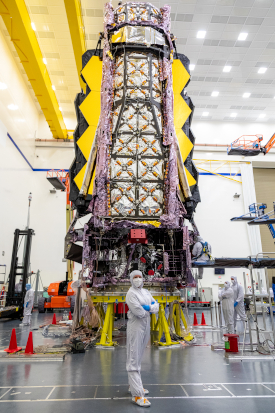
Stefanie Milam, inside the cleanroom where the James Webb Space Telescope resided. (Photo: Courtesy of Stefanie Milam)
And so as we explore our solar system, and we get new spacecraft going to Jupiter, or to Titan, one of the moons of Saturn, or even one of these moons around Jupiter that we think has a subsurface ocean, it's called Europa, we think there's all kinds of extremely interesting environments that could be sustainable for something like life. And so understanding what that chemistry looks like, understanding what the composition of these bodies are, and how that may or may not change is something extremely interesting for planetary science and exploration. And so the James Webb Space Telescope is gonna sort of reveal a lot of these details of these objects in our own solar system that we've never been able to really study with this kind of sensitivity. It helps us provide the right information and level of detail as we send the next generation of planetary explorers out there. So making sure we have the right instrumentation to look for water-like chemistry, or aqueous chemistry. Or if there isn't water there, what is there? Then we can start optimizing our instrumentation so that we're sending the right things there at the right time. This actually applies as we look at other planets around other stars as well. It's the same chemistry that we're gonna be looking at, in these planets called exoplanets, because they're beyond our own solar system. So we're gonna be studying them in the same way that we study the planets in our own solar system. So now we have a comparison that we can actually understand something that's so far away, maybe not quite tangible yet. But we can still get a better understanding of what those planets are made of. And maybe they have an atmosphere, maybe they have volcanoes, maybe they have giant ice oceans. These are the kinds of things that the James Webb Space Telescope gonna help reveal.
CURWOOD: And then you're gonna look to see what exosolar planets, planets around other stars, see how they might match these. And of course, you already have the data for Earth, so you can see if any one of them exactly or closely matches us.
MILAM: Yeah, so the idea is looking for something like an Earth 2.0, is something that, you know, humankind has this innate sense of, you know, discovery that we want to know if there's life out there, if there's another world that we could live on, or you know, travel to at some point. And so searching for something that looks like Earth is of key interest. Plus, it gives us a target for the extremely large number of objects. Now, we're over 5000 exoplanets known today. And so it gives us sort of a short list of objects to start studying, especially when it comes to key questions of things like habitability. So we're not gonna be seeing life itself with the James Webb Space Telescope, we're looking for these key fingerprints of specific molecules that may provoke some sort of unique chemistry happening. And that's some sort of process that's making the chemistry of that planet look different. And that could be because of life. It could be because of geologic processing, so volcanoes, or giant sand storms, or weather, or maybe there's crazy clouds in the atmosphere, like on Venus. These are the kinds of things that we're gonna be studying so that we get a further understanding of these planets, maybe get the list a little bit shorter, even still, with the James Webb Space Telescope, so that the next generation of space telescopes or Explorer missions will be able to study them in even more detail.

This photo, taken during the alignment process, shows that the James Webb Space Telescope’s optical performance is on track to meet or even exceed the goals it was built to achieve. The image intended to focus on the bright center star, but the sensitivity of the telescope is such that the background galaxies and stars are also visible. (Photo: NASA, STSci, Public Domain)
CURWOOD: So now, what's the timeline for this project? For a moment, let's go back to when it was first conceived, and then tell me how long this mission is expected to last.
MILAM: So going all the way back to the early 90s was when a group of scientists decided that the discovery space that Hubble has opened up was just not quite good enough. And they knew that they were gonna hit a limit. And so this actually came out of an experiment that happened with the Hubble Space Telescope, where they basically stared at a blank piece of sky for a considerable number of hours. And what they found was not blank sky, they actually found thousands of galaxies within something that's the size of your fingernail, if you stuck it up on the sky. Thousands of galaxies, but what happened was, is when they started analyzing the data and seeing how far back in time, they could see, what was the oldest galaxy that we could study with the Hubble Space Telescope, they were blown away about the discovery space that Hubble actually had and the capability that it had. But there was a limit, there was a wall. We couldn't quite push any further. And so to get further, we had to have something much bigger, much more sensitive, and something that actually was optimized for infrared wavelengths. And so that’s sort of how JWST evolved, from, you know, the Hubble Space Telescope to this massive infrared telescope. You know, this beautiful gold mirror, this crazy boat looking structure underneath it to keep it nice and cold, and putting this telescope a million miles away from Earth so that it could stay cold and operate. Putting it that far away, unfortunately means that we do have a limited life mission, because we can't send astronauts there currently, to go and service the telescope the way, that we've serviced the Hubble Space Telescope for decades. So what that means is we had to carry a certain amount of fuel to operate the telescope, to do things like offset momentum, to make sure we stay in the right place in its orbit. And also just to control the telescope. Fortunately, we had a very beautiful launch with Arianespace, we were on a rocket that launched out of French Guiana that was provided by the European Space Agency. It sent us on a beautiful trajectory, a million miles away from Earth. And we were actually able to conserve a lot of fuel, which means that our mission lifetime went from a ten-year that we were projecting at launch to something that looks more like 20 years of operations now.
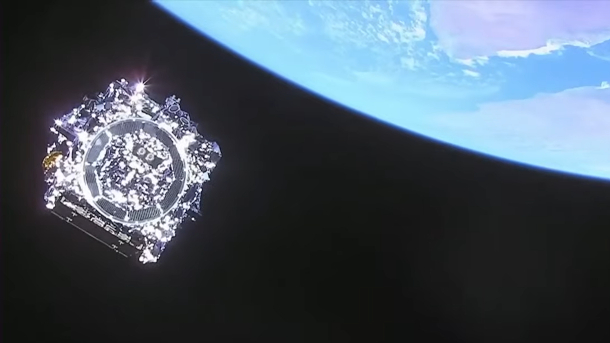
The James Webb Space Telescope, seen shortly after separation, as photographed from the upper stage of the Ariane 5 rocket. (Photo: NASA, Public Domain)
CURWOOD: So there have been some calibration and alignment photos from the James Webb Space Telescope already. But when are we gonna start to see the first scientific photos, both the stuff that you care about nearby and the deep space stuff?
MILAM: Well, I will honestly tell you that all of the calibration images we've seen so far has been absolutely amazing and astonishing for me and the whole project. And every single day, we get to see more and more of these. And it's all the more impressive of how well this observatory actually works and really exciting to think about what it's going to do for us. But the first science images are actually going to be released in the summer. So late June to mid July, that time is still to be determined depending on how well commissioning goes. They'll all be released at once. There'll be some probably NASA event going on. And some online, you know, you can log in and follow along with us. But as soon as that happens, it's basically the initiation of science operations for the James Webb Space Telescope. So we already have our first year of science observations already planned. It includes everything from solar system observations, deep studies of the distant universe, studying planets around other stars, watching planets and stars being formed in their own stellar nurseries in our galaxy and in the universe, how galaxies merge together, how they evolve, how stars evolve, what happens when they die, all kinds of really amazing science, that I don't know if there's a way to prioritize it as far as enthusiasm. But I think it's all gonna to be exciting, and we're gonna rewrite the textbooks.
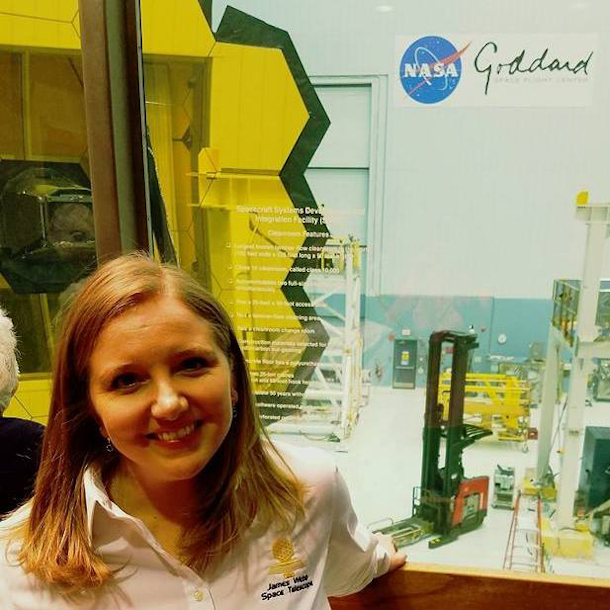
Stefanie Milam, outside the cleanroom where the James Webb Space Telescope resided. (Photo: Courtesy of Stefanie Milam)
CURWOOD: Stefanie, what are you personally most excited to study with the data we're gonna be getting from the James Webb Space Telescope?
MILAM: Well, so I'm a cometary scientist. So I study comets in our solar system. And I also study interstellar objects, which are new things that we've discovered in our solar system. So these are comets or asteroids that come from other planetary systems. So what we learned from comets is basically, how the solar system actually formed. What was the process? What was the chemistry like? How did something like Earth, with liquid water on its surface, all the right ingredients to have biology, biochemistry, how did that all get here in the right place? The right time, the right composition? What were those ingredients? And if those ingredients are something that are ubiquitous across our whole galaxy or other planetary systems, then that's something that will give us key insights into what kind of planets, what kind of planetary systems, or even what kind of star forming systems or regions we need to be looking for in our search for this Earth 2.0. So comets are basically, you know, the relics or fossils of when our solar system formed. So by studying them, we learn a lot about all of those key ingredients, all of the processing that happened during the formation of the solar system. And so the James Webb Space Telescope is actually very accessible to studying these objects.
CURWOOD: But wait, you said that there are some comets from other solar systems? What about that? How the heck did they get here? And what do they tell us?
MILAM: Yeah, so we now have discovered two interstellar objects. One of them looked like an asteroid or a spaceship to some people. It was called ʻOumuamua. And the second one actually looked like a comet, and it was called Borisov. We expect with all the new surveying telescopes that are coming online, such as the Rubin Observatory down in South America, as well as a number of other large surveying capabilities that are being built and getting ready to be operational, we're gonns to discover more and more of these kinds of objects. So these are basically the the comets or asteroids that whenever another planetary system is forming, maybe they collided with another one. And it bumped it off course, such that it got ejected from its own planetary system. We've anticipated and expected this is something that happens with our own small bodies in our solar system. But I don't know that anyone ever really anticipated that we'd actually discover one from another planetary system in our own solar system. So it was extremely exciting for this discovery to actually happen a few years ago.
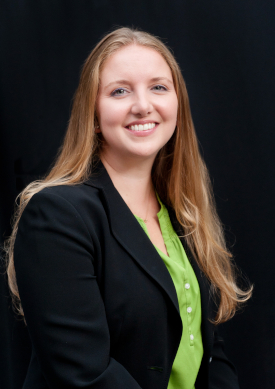
Stefanie Milam is NASA’s Deputy Project Scientist for Planetary Science for the James Webb Space Telescope. (Photo: Courtesy of Stefanie Milam)
And now that we found two, that are completely different from one another, your imagination goes wild. What does this mean? What is this telling us about one, not only the planetary system that they formed in, but what does it tell us about the journey that that object had to have going from its planetary system through space, and the harsh conditions of radiation from nearby supernova, or stars colliding with each other, or new planetary systems forming or whatever, all the way on its journey to get to our own planetary system. So there's all kinds of things that are really interesting about these objects. We're so excited for the next discovery of one, and all hands are on deck to observe it with every every telescope on Earth and in space.
CURWOOD: If you discover it, is it gonna be called the Milam Comet?
MILAM: Yes.
CURWOOD: Woah!
MILAM: Well, so far, comets are named after their discoverers. And so far, interstellar objects are named for their discoverers. So we'll see.
CURWOOD: You haven't discovered one yet, but...
MILAM: I haven't discovered one yet. But I will say asteroids also get designated name. And so I do have an asteroid named after me.
CURWOOD: Oh, and that one is called?
MILAM: Milam.
CURWOOD: How big is Milam?
MILAM: It's small. I think it's about 10 meters is what they're predicting.
CURWOOD: So about 30 feet wide.
MILAM: Yeah, not very big. It's in the main belt. It's, it's a rock. But it's my rock. So it's a really cool rock.
CURWOOD: Stefanie Milam is the Deputy Project Scientist for Planetary Science for the James Webb Space Telescope. Thanks so much for taking the time with us today.
MILAM: Thank you so much for having me. This was a lot of fun.
Related links:
- Scientific American The James Webb Space Telescope Could Solve One of Cosmology’s Deepest Mysteries
- Read more on the James Webb Space Telescope at the official NASA site
- Stefanie Milam’s biography page
- The James Webb Space Telescope on Twitter
- Stefanie Milam on Twitter
“How to Love the Stars”
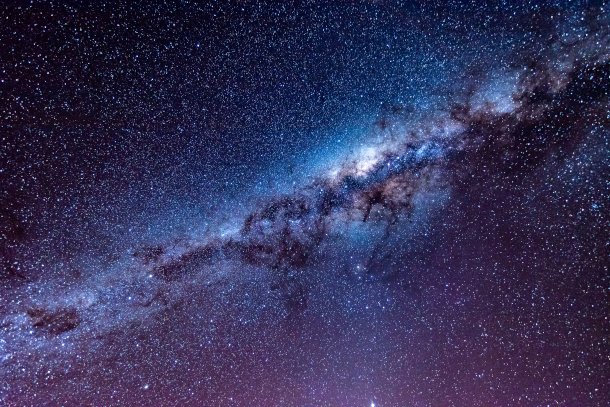
Jennifer Junghans observes that the stars are “light memories from the same stars the first hominids looked up and saw.” (Photo: Graham Holtshausen on Unsplash)
[MUSIC: Blue Dot Sessions, “The Onyx”]
BASCOMB: Well, you don't need a $10 billion telescope to take in the wonder of the universe. You can make a simple one yourself, or even just look up with your own two eyes. And for writer Jennifer Junghans, that connection to the stars is also a connection to her dad.
JUNGHANS: It’s a muscle memory now, to look up and search the night sky. Even if just for a moment to return to the time when I was young and my dad was too, him bursting with enthusiasm to unlock for my sister and me all the magic that lived in those stars.
He’d fiddle with the Dobsonian telescope he built, making endless minute adjustments. At last, he’d usher us to peer through the eyepiece at the magnified stars before Earth rotated them out of view.
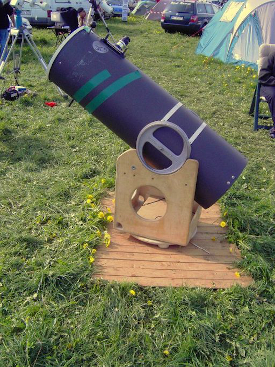
A homemade Dobsonian telescope (Photo: ECeDee, Wikimedia Commons public domain)
He’d name the stars and point upward connecting the dots for us into constellations that I could never quite make out. Always with an urgency, as though his work as a father wouldn’t be done until he taught us how to love the stars.
I think he wanted us to know how to lose ourselves in the mysteries of the twinkling sky. To believe in possibilities beyond what we know. To accept with certainty, we’re supposed to be here even though we don’t yet understand how we fit into the grand scheme of the universe.
[MUSIC: Blue Dot Sessions, “The Onyx”]
Beyond the dazzling beauty, I fell in love with the constancy of the night sky. All the loss in our lives, the dreams that never came to be, the loneliness … I forget it all when I stargaze and bathe in the galaxy.
The signatures of light we see are the museums of these gaseous, fiery balls that have burned and pulsed for millions sometimes billions of years. They’re light memories from the same stars the first hominids looked up and saw. The same ones that lit the sky when dinosaurs roamed.
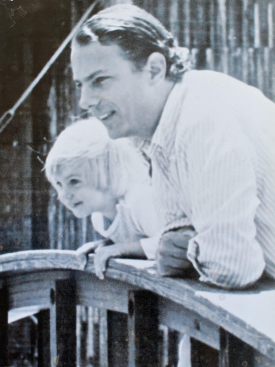
A young Jennifer Junghans with her dad, who taught her “how to love the stars” with a homemade telescope. (Photo: Courtesy of Jennifer Junghans)
The time continuum is almost unfathomable, this stitching together of all who came eons before us and all who will come after, bound in the accumulated history of the stars. They are the universal witnesses. And in this way, nothing is forgotten and everything still exists.
[MUSIC: Blue Dot Sessions, “The Onyx”]
I find great comfort in that as my dad’s memories dim. He’s transitioning like a giant star about to expire, exploding into a luminous, spectacular supernova. In the same way, his energy will outlast his physical body. I wonder where it will go? Could it disperse into the universe and form a new star that burns for another billion years?
It’s a legacy I think my dad would love. And it’s the one I’ll hold on to. Believing that when I look up into the night sky, it’s my dad’s light I’ll see.
[MUSIC: Blue Dot Sessions, “The Onyx”]
BASCOMB: That's writer Jennifer Junghans with her essay, "How to Love the Stars."
[MUSIC: Blue Dot Sessions, “The Onyx”]
Related links:
- Watch: Step-by-step making of a Dobsonian telescope, with amateur astronomer John Dobson
- Jennifer Junghans’ website
The Living on Earth Book Club is Back!
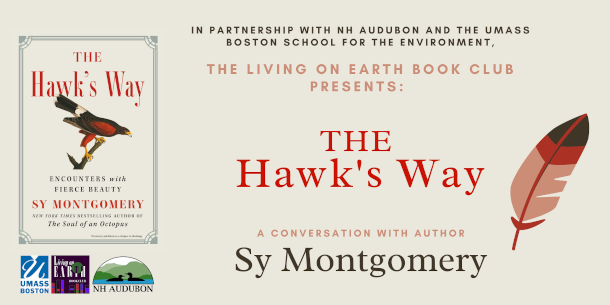
From the first moment Jazz, a feisty, four-year-old, female Harris’s hawk, swept down from a tree and landed on Sy’s leather gloved fist, Sy fell under the hawk’s magnetic spell. Over the next few years, Sy spent more time with these magnificent creatures, getting to know their extraordinary abilities and instincts. They are deeply emotional animals, quick to show anger and frustration, and can hold a grudge for years. But they are also loyal and intensely aware of their surroundings. In The Hawk’s Way, Sy passionately and vividly reveals the wondrous world of hawks and what they can teach us about nature, life, and love.
Living on Earth presents this conversation with Sy Montgomery alongside NH Audubon, New Hampshire Public Radio, and the UMass Boston School for the Environment as part of the Living on Earth Book Club.
Join us for this in-person event on April 25th at 5:30 p.m. Eastern at the NH Audubon McLane Center at 84 Silk Farm Rd., Concord, NH 03301. Follow the link below to register for the in-person event or for the virtual livestream.
If you have any questions, please reach out to comments@loe.org.
Related links:
- Register for the in-person and virtual event
- Purchase a copy of The Hawk's Way (Affiliate link helps donate to LOE and local indie bookstores)
CURWOOD: Living on Earth is produced by the World Media Foundation. Our crew includes Naomi Arenberg, Paloma Beltran, Chloe Chen, Iris Chen, Josh Croom, Gabriella Diplan, Jenni Doering, Mark Kausch, Mark Seth Lender, Don Lyman, Louis Mallison, Aynsley O’Neill, Sophia Pandelidis, Jake Rego, Teresa Shi, and Jolanda Omari.
BASCOMB: Tom Tiger engineered our show. Alison Lirish Dean composed our themes. You can hear us anytime at L-O-E dot org, Apple Podcasts and Google Podcasts, and like us, please, on our Facebook page - Living on Earth. We tweet from @livingonearth. And find us on Instagram at livingonearthradio. I’m Bobby Bascomb.
CURWOOD: And I’m Steve Curwood. Thanks for listening!
ANNOUNCER: Funding for Living on Earth comes from you, our listeners, and from the University of Massachusetts, Boston, in association with its School for the Environment, developing the next generation of environmental leaders. And from the Grantham Foundation for the protection of the environment, supporting strategic communications and collaboration in solving the world’s most pressing environmental problems.
ANNOUNCER 2: PRX.
Living on Earth wants to hear from you!
Living on Earth
62 Calef Highway, Suite 212
Lee, NH 03861
Telephone: 617-287-4121
E-mail: comments@loe.org
Newsletter [Click here]
Donate to Living on Earth!
Living on Earth is an independent media program and relies entirely on contributions from listeners and institutions supporting public service. Please donate now to preserve an independent environmental voice.
NewsletterLiving on Earth offers a weekly delivery of the show's rundown to your mailbox. Sign up for our newsletter today!
 Sailors For The Sea: Be the change you want to sea.
Sailors For The Sea: Be the change you want to sea.
 The Grantham Foundation for the Protection of the Environment: Committed to protecting and improving the health of the global environment.
The Grantham Foundation for the Protection of the Environment: Committed to protecting and improving the health of the global environment.
 Contribute to Living on Earth and receive, as our gift to you, an archival print of one of Mark Seth Lender's extraordinary wildlife photographs. Follow the link to see Mark's current collection of photographs.
Contribute to Living on Earth and receive, as our gift to you, an archival print of one of Mark Seth Lender's extraordinary wildlife photographs. Follow the link to see Mark's current collection of photographs.
 Buy a signed copy of Mark Seth Lender's book Smeagull the Seagull & support Living on Earth
Buy a signed copy of Mark Seth Lender's book Smeagull the Seagull & support Living on Earth

